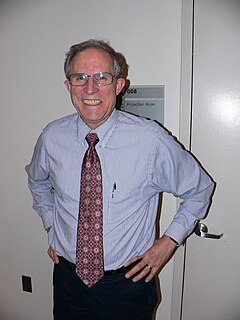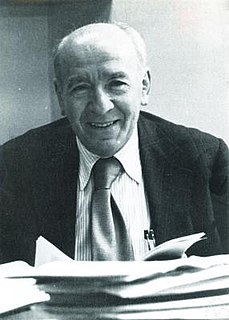Related Research Articles

David Harold Bailey is a mathematician and computer scientist. He received his B.S. in mathematics from Brigham Young University in 1972 and his Ph.D. in mathematics from Stanford University in 1976. He worked for 14 years as a computer scientist at NASA Ames Research Center, and then from 1998 to 2013 as a Senior Scientist at the Lawrence Berkeley National Laboratory. He is now retired from the Berkeley Lab, but continues as a Research Associate at the University of California, Davis, Department of Computer Science.

The Mathematical Association of America (MAA) is a professional society that focuses on mathematics accessible at the undergraduate level. Members include university, college, and high school teachers; graduate and undergraduate students; pure and applied mathematicians; computer scientists; statisticians; and many others in academia, government, business, and industry.

The American Mathematical Society (AMS) is an association of professional mathematicians dedicated to the interests of mathematical research and scholarship, and serves the national and international community through its publications, meetings, advocacy and other programs.

Paul Richard Halmos was a Hungarian-born American mathematician and statistician who made fundamental advances in the areas of mathematical logic, probability theory, statistics, operator theory, ergodic theory, and functional analysis. He was also recognized as a great mathematical expositor. He has been described as one of The Martians.

Mark Kac was a Polish American mathematician. His main interest was probability theory. His question, "Can one hear the shape of a drum?" set off research into spectral theory, with the idea of understanding the extent to which the spectrum allows one to read back the geometry.
Jonathan Michael Borwein was a Scottish mathematician who held an appointment as Laureate Professor of mathematics at the University of Newcastle, Australia. He was a close associate of David H. Bailey, and they have been prominent public advocates of experimental mathematics.
Peter Benjamin Borwein was a Canadian mathematician and a professor at Simon Fraser University. He is known as a co-author of the paper which presented the Bailey–Borwein–Plouffe algorithm for computing π.
Andrew James Granville is a British mathematician, working in the field of number theory.

Dunham Jackson was a mathematician who worked within approximation theory, notably with trigonometrical and orthogonal polynomials. He is known for Jackson's inequality. He was awarded the Chauvenet Prize in 1935. His book Fourier Series and Orthogonal Polynomials was reprinted in 2004.
The Paul R. Halmos – Lester R. Ford Award is a $1,000 prize given annually by the Mathematical Association of America for authors of articles of expository excellence published in The American Mathematical Monthly or Mathematics Magazine. It is awarded to at most four authors each year. The prize was established in 1964 as the Lester R. Ford Award to honor the contributions of mathematician and former MAA president Lester R. Ford. In 2012 the award was renamed the Paul R. Halmos – Lester R. Ford Award to honor the contributions of former The American Mathematical Monthly editor Paul R. Halmos and the support of the Halmos family for the awards. Halmos himself received the award in 1971 and 1977.
John Michael Steele is C.F. Koo Professor of Statistics at the Wharton School of the University of Pennsylvania, and he was previously affiliated with Stanford University, Columbia University and Princeton University.
William Wade Dunham is an American writer who was originally trained in topology but became interested in the history of mathematics and specializes in Leonhard Euler. He has received several awards for writing and teaching on this subject.

Martin Aigner is an Austrian mathematician and professor at Freie Universität Berlin since 1974 with interests in combinatorial mathematics and graph theory.

Carolyn S. Gordon is a mathematician and Benjamin Cheney Professor of Mathematics at Dartmouth College. She is most well known for giving a negative answer to the question "Can you hear the shape of a drum?" in her work with David Webb and Scott A. Wolpert. She is a Chauvenet Prize winner and a 2010 Noether Lecturer.
The Euler Book Prize is an award named after Swiss mathematician and physicist Leonhard Euler (1707-1783) and given annually at the Joint Mathematics Meetings by the Mathematical Association of America to an outstanding book in mathematics that is likely to improve the public view of the field.

Stanley Wagon is a Canadian-American mathematician, a professor of mathematics at Macalester College in Minnesota. He is the author of multiple books on number theory, geometry, and computational mathematics, and is also known for his snow sculpture.
Erica Flapan is an American mathematician, the Lingurn H. Burkhead Professor of Mathematics at Pomona College.
Lawrence Allen Zalcman was professor emeritus of Mathematics at Bar-Ilan University. His research concerns Complex analysis and potential theory, and their relations with approximation theory, harmonic analysis, integral geometry and partial differential equations. On top of his scientific achievements, Zalcman received numerous awards for mathematical exposition, including the Chauvenet Prize in 1976, the Lester R. Ford Award in 1975 and 1981, and the Paul R. Halmos – Lester R. Ford Award in 2017.
The Merten M. Hasse Prize is awarded every two years by the Mathematical Association of America (MAA) to recognize an exceptional expository paper appearing in an MAA publication, at least one of whose authors is a younger mathematician, generally under the age of forty. First awarded in 1987, the prize honors inspiring and dedicated teachers and encourages young mathematicians to take up the challenge of exposition and communication.
David Allen Hoffman is an American mathematician whose research concerns differential geometry. He is an adjunct professor at Stanford University. In 1985, together with William Meeks, he proved that Costa's surface was embedded. He is a fellow of the American Mathematical Society since 2018, for "contributions to differential geometry, particularly minimal surface theory, and for pioneering the use of computer graphics as an aid to research." He was awarded the Chauvenet Prize in 1990 for his expository article "The Computer-Aided Discovery of New Embedded Minimal Surfaces". He obtained his Ph.D. from Stanford University in 1971 under the supervision of Robert Osserman.
References
- 1 2 "Chauvenet Prizes". Mathematical Association of America.
- ↑ "Regulations Governing the Award of The Chauvenet Prize". Mathematical Association of America.
- 1 2 Zorn, Paul (2015-08-23). A Century of Advancing Mathematics. The Mathematical Association of America. ISBN 9780883855881.
- ↑ "Walter Burton Ford, 1927-1928 MAA President | Mathematical Association of America". www.maa.org. Retrieved 2022-11-14.
- ↑ "Prize Booklet 2017" (PDF). American Mathematical Society. p. 6.
- ↑ Velleman, Daniel J. (November 2015). "The Fundamental Theorem of Algebra: A Visual Approach" (PDF). The Mathematical Intelligencer. 37 (4): 12–21. doi:10.1007/s00283-015-9572-7. ISSN 0343-6993.
- ↑ "JMM Prizebook 2019" (PDF). Joint Mathematics Meetings. p. 1.
- ↑ Leinster, Tom (2014) [28 Dec 2012]. "Rethinking Set Theory". The American Mathematical Monthly. 121 (5): 403. arXiv: 1212.6543 . doi:10.4169/amer.math.monthly.121.05.403.
- ↑ "JMM Prizebook 2020" (PDF). American Mathematical Society. p. 55.
- ↑ Pozdnyakov, Vladimir; Steele, J. Michael (June 2016) [22 Dec 2017]. "Buses, Bullies, and Bijections". Mathematics Magazine. 89 (3): 167–176. doi:10.4169/math.mag.89.3.167. ISSN 0025-570X.
- ↑ "2021 Prizes and Awards". Joint Mathematics Meetings . Retrieved 2021-01-12.
- ↑ Kowalski, Travis (November 2016). "The Sine of a Single Degree". The College Mathematics Journal. 47 (5): 322–332. doi:10.4169/college.math.j.47.5.322. ISSN 0746-8342.